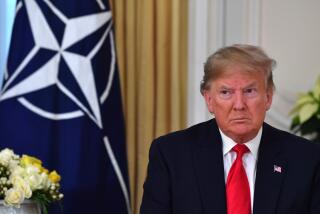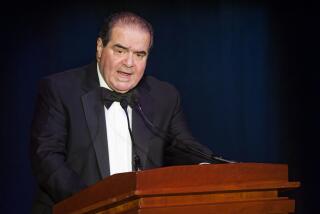Arms Control and German Fears :...
Military historian B. H. Liddell-Hart used to tweak the sensibilities of platitudinous colleagues by writing of “turning points in history--where history refused to turn.” With a Soviet-American treaty apparently about to be signed banning intermediate-range missiles in Europe, the modern history of arms control may be approaching such a fateful intersection. But it remains to be seen whether history--a juggernaut whose motive force is often irony--will make the curve.
“Superpower Arms Control” is a scholarly account of earlier efforts to limit the number and/or threat of nuclear weapons. Written by a new generation of the “Cambridge Mafia” of Harvard scholars, the book frankly acknowledges that the accomplishments of arms control have thus far been depressingly meager.
The first, and perhaps most telling, proof of this thesis is the book’s chapter on the 1963 Limited Test-Ban Treaty, which was an early goal of the Eisenhower Administration but was only achieved by the efforts of President Kennedy nearly a decade later. It was widely hoped that the treaty--which bans nuclear explosions in the atmosphere, the oceans, and outer space, but not underground--would eventually lead to a new arms-control regime, where all nuclear testing might be proscribed. Instead, the LTBT has proved to be more of an environmental than an arms control measure--a kind of a radioactive pollution-control law--which has not only failed to slow the development of new nuclear weapons, but may even had made testing more publicly acceptable by forcing it underground and hence out of sight. The end of above-ground testing has also made it more difficult for each side to know what the other is doing in its weapons tests, and has thereby added a new element of uncertainty and suspicion.
Six other essays detail similar disappointments and false hopes that have followed in the wake of negotiations to ban anti-satellite weapons, curb nuclear proliferation, and limit the development or deployment of new strategic arms. Observes the author of the chapter on SALT II: “Severe constraints were achieved only on weapons that neither side really wanted . . . or had not tested.”
Elsewhere, what was once hailed as the solution is now recognized to have been but the genesis of a new and less tractable problem. Thus SALT, one Harvard scholar writes, is an illustration of the “balloon theory” of arms control: Squeezing the arms race in one place only causes it to pop out somewhere else. Putting limits upon quantity has only encouraged improvements in quality--which, in this case, has meant more numerous and more accurate warheads upon the missiles whose numbers were restricted by the treaty.
Dismal as the record has been, the Harvard group does not propose that we abandon arms control efforts altogether. Thus, as even the Pentagon has been forced to admit, past agreements with the Russians have been useful in reducing uncertainties (with the exception of the test-ban treaty), and helpful in directing the arms competition into channels that are at least more predictable, even if still far from harmless.
Perhaps most disappointing is the fact that “Superpower Arms Control” was written before the Gorbachev-induced phenomena of glasnost began to affect Soviet-American relations, so there is no chapter on the intermediate-range nuclear force (INF) negotiations that are presently the source of renewed hope and expectation.
Partly filling that gap--and adding a European perspective in the process--is “The Limited Partnership” by Josef Joffe, the foreign editor of Munich’s Suddeutsche Zeitung. Joffe received his Ph.D. in government from the John F. Kennedy School where Carnesale and Haass teach, and apparently shares his professors’ middle-of-the-road point of view regarding the Russians. Joffe’s focus, however, is not the mind-numbing nuclear accountancy of the superpowers but the often combative and sometimes troubled relationship of the United States with its NATO allies, particularly West Germany. “The Limited Partnership” is, in fact, an extended essay--or editorial--on the state of the Western alliance. Written in an engaging, colloquial style, the book attempts to explain to Americans why their allies regard the United States as “an elephant in a lifeboat,” and why there was more than “protestant Angst”--in the words of a former Pentagon official--behind the objections of Britons and Germans to having new U.S. missiles installed in their backyards. As Joffe gently points out, bombs that the United States has long regarded as “tactical” are in fact “Euro-strategic”; what we tend to see as a “theatre” of operations is where the Germans live and their children play.
Accordingly, the book’s most interesting section deals with the ongoing debate among European and American strategists over the best way of defending the Continent against Soviet invasion. One by one, the author considers--and rejects--the proposed alternatives to NATO’s 40-year-old strategy of threatening the use of nuclear weapons once the first Russian soldier steps upon West German soil. Ultimately, Joffe’s answer is an unabashed--if not altogether convincing--defense of things-as-they-are, where the security of Europe would continue to rely upon an American nuclear guarantee: “Nuclear deterrence in Europe has a record, conventional defense has not, and four decades of ultra stability is an impressive argument for the status quo.”
Paradoxically, Joffe’s case for “ultra stability” and the status quo comes at a time when NATO seems about to face the most serious challenge since its founding in 1949. Thus, as Joffe himself admits, Gorbachev’s recently expressed vision of a denuclearized “common house of Europe” is almost certain to prove a greater threat to the cohesion of the alliance than the “dense palisade of missiles” that the Russians initially threatened when walking out of the INF negotiations about four years ago.
Unfortunately, Joffe’s book, too, was completed before the effect of Gorbachev’s reforms began to be fully felt in the alliance. But even if the now-supposedly imminent INF agreement becomes another of those turning points where history stubbornly refuses to budge, the likelihood is that glasnost and perestroika will force changes in the status quo of arms control and alliance politics which will be broader and further-reaching than either of these books allow.
More to Read
Sign up for our Book Club newsletter
Get the latest news, events and more from the Los Angeles Times Book Club, and help us get L.A. reading and talking.
You may occasionally receive promotional content from the Los Angeles Times.







